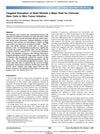Impact of mTORC1 Inhibition on Keratinocyte Proliferation During Skin Tumor Promotion in Wild-Type and BK5.AktWT Mice
September 2013
in “
Molecular carcinogenesis
”
TLDR Rapamycin reduces skin cell growth and tumor development by affecting cell signaling in mice.
The study investigated the effects of mTORC1 inhibition on keratinocyte proliferation and skin tumor promotion in wild-type and BK5.Akt^WT mice. It was found that inhibiting mTORC1 with rapamycin significantly reduced TPA-induced keratinocyte proliferation, epidermal hyperplasia, and tumor promotion in both mouse models. Additionally, rapamycin prevented the migration of label-retaining cells (LRCs) from hair follicles to the epidermis, indicating mTORC1's role in keratinocyte stem/progenitor cell proliferation and migration. The findings highlighted the critical role of mTORC1 signaling in skin tumor promotion and suggested that targeting mTORC1 could be an effective strategy for preventing skin cancer.

